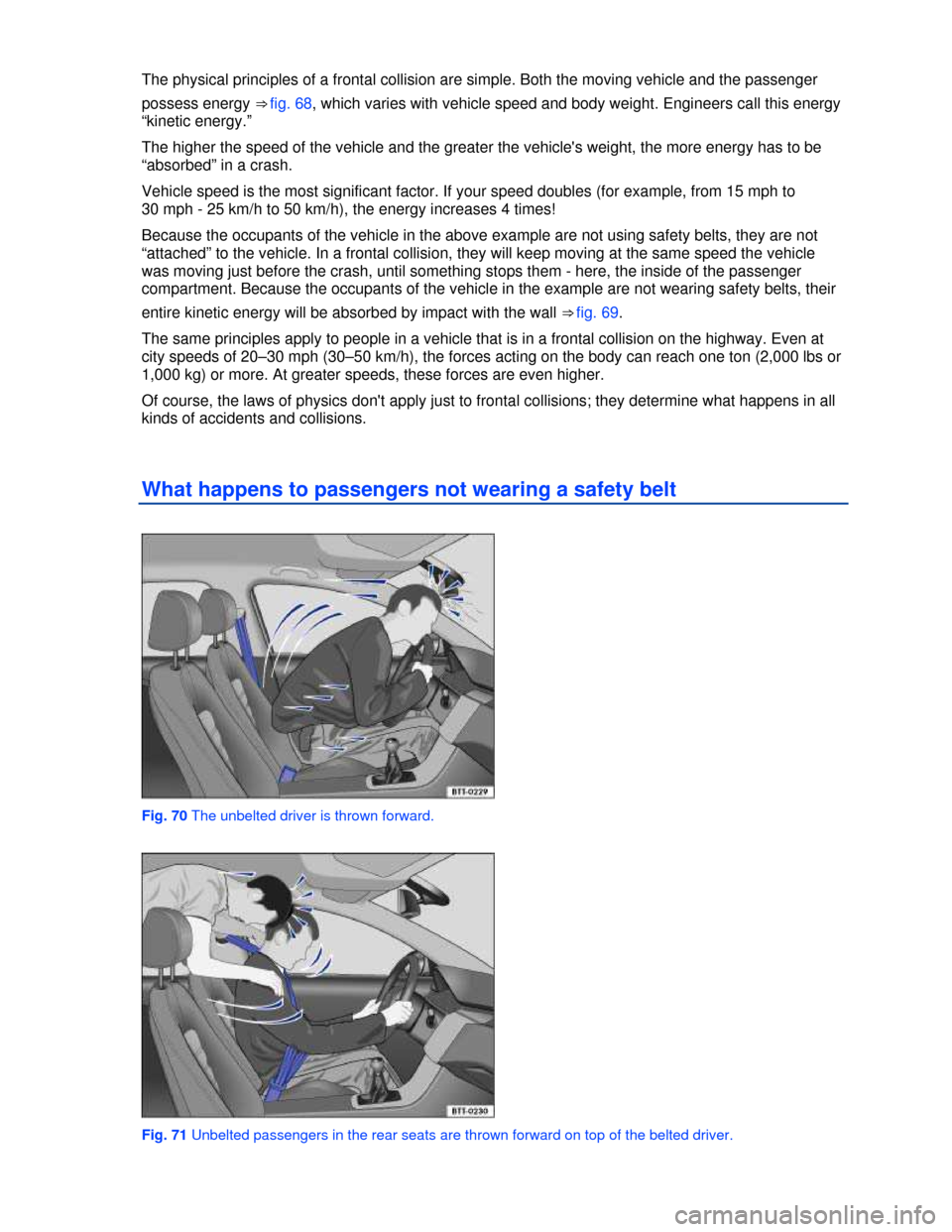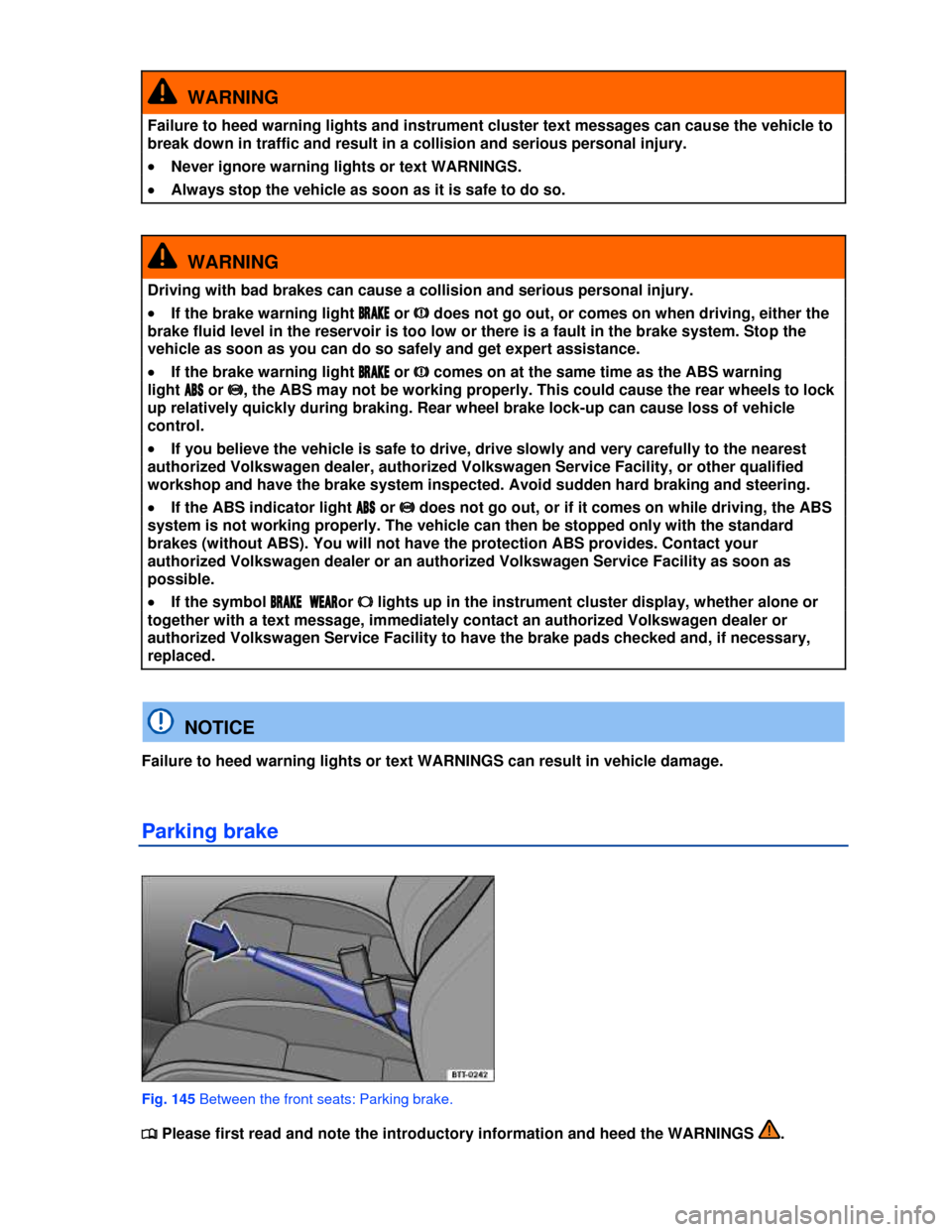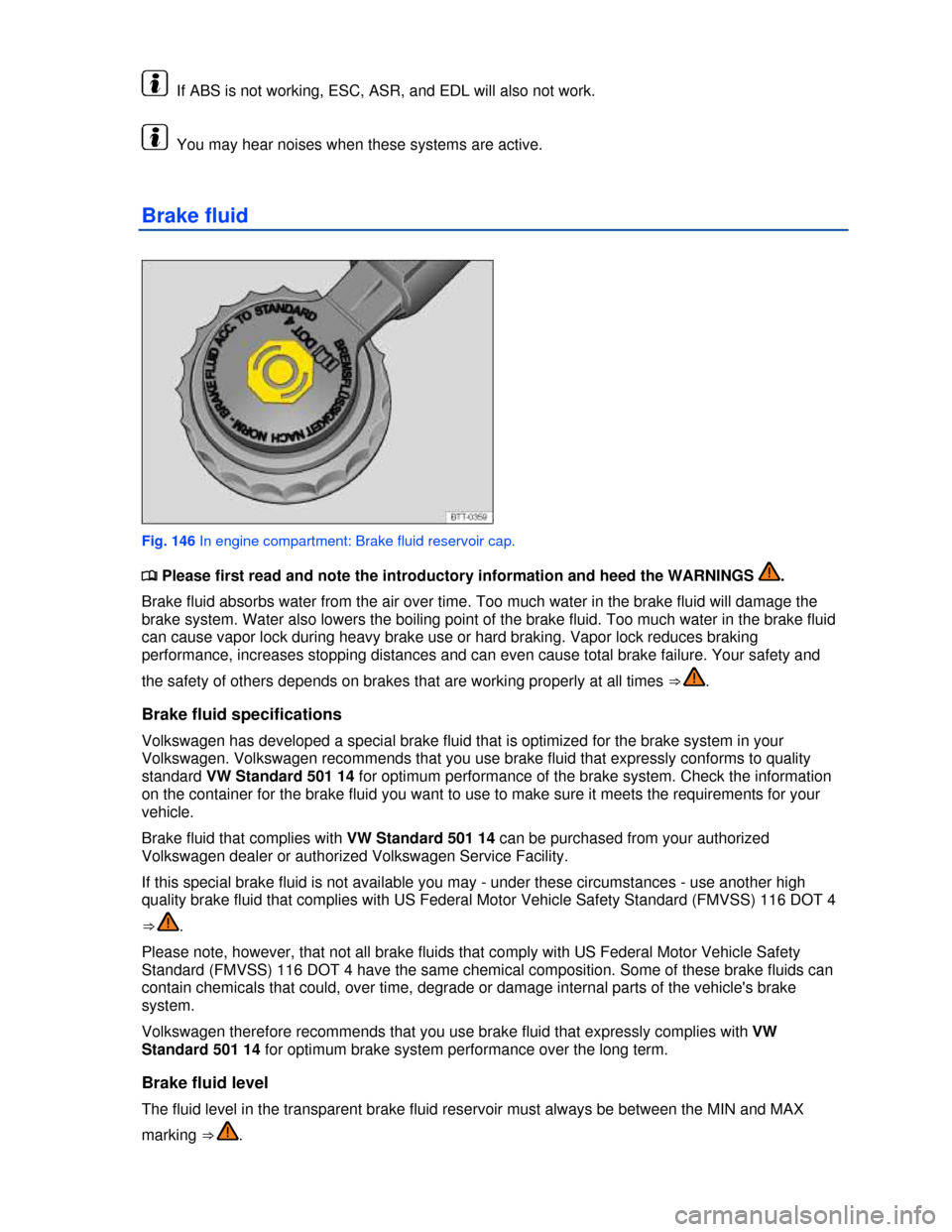ABS VOLKSWAGEN PASSAT 2013 B8 / 6.G Owners Manual
[x] Cancel search | Manufacturer: VOLKSWAGEN, Model Year: 2013, Model line: PASSAT, Model: VOLKSWAGEN PASSAT 2013 B8 / 6.GPages: 379, PDF Size: 5.56 MB
Page 117 of 379

The physical principles of a frontal collision are simple. Both the moving vehicle and the passenger
possess energy ⇒ fig. 68, which varies with vehicle speed and body weight. Engineers call this energy
“kinetic energy.”
The higher the speed of the vehicle and the greater the vehicle's weight, the more energy has to be
“absorbed” in a crash.
Vehicle speed is the most significant factor. If your speed doubles (for example, from 15 mph to
30 mph - 25 km/h to 50 km/h), the energy increases 4 times!
Because the occupants of the vehicle in the above example are not using safety belts, they are not
“attached” to the vehicle. In a frontal collision, they will keep moving at the same speed the vehicle
was moving just before the crash, until something stops them - here, the inside of the passenger
compartment. Because the occupants of the vehicle in the example are not wearing safety belts, their
entire kinetic energy will be absorbed by impact with the wall ⇒ fig. 69.
The same principles apply to people in a vehicle that is in a frontal collision on the highway. Even at
city speeds of 20–30 mph (30–50 km/h), the forces acting on the body can reach one ton (2,000 lbs or
1,000 kg) or more. At greater speeds, these forces are even higher.
Of course, the laws of physics don't apply just to frontal collisions; they determine what happens in all
kinds of accidents and collisions.
What happens to passengers not wearing a safety belt
Fig. 70 The unbelted driver is thrown forward.
Fig. 71 Unbelted passengers in the rear seats are thrown forward on top of the belted driver.
Page 162 of 379

Driving with an open luggage compartment lid can lead to serious personal injury. If you have to drive
with an open luggage compartment lid, make sure that all objects and the lid itself are properly se-
cured and take appropriate measures to keep toxic exhaust fumes from entering the vehicle.
WARNING
Driving with an unlatched or open luggage compartment lid can lead to serious personal
injury.
�x Never transport objects larger than those that fit completely in the luggage compartment,
because the luggage compartment lid cannot be fully closed properly.
�x After closing the lid, always pull up on it to make sure that it is properly closed and cannot
open suddenly when the vehicle is moving.
�x Always stow all objects securely in the luggage compartment. Loose objects can fall out
of the luggage compartment and injure others on the road behind you.
�x Drive carefully; anticipate what other drivers will do.
�x Avoid abrupt or sudden acceleration, steering, or braking, because the unlatched luggage
compartment lid can move suddenly.
�x Always mark objects sticking out from the luggage compartment clearly for others to see.
Obey all applicable legal requirements.
�x Never use the luggage compartment lid to “clamp” or “hold” objects that stick out of the
luggage compartment.
�x Always remove any luggage rack or other rack mounted on the luggage compartment lid
(along with any luggage on the rack) before driving with an open luggage compartment lid.
WARNING
Driving with an open luggage compartment lid can cause poisonous carbon monoxide in the
engine exhaust to get into the passenger compartment.
�x Carbon monoxide causes drowsiness, inattentiveness, poisoning, and loss of conscious-
ness. It can lead to accidents and severe personal injuries.
�x Always keep the luggage compartment lid closed while driving to help keep poisonous
exhaust fumes from being drawn into the vehicle.
�x Never transport objects that are too large to fit completely into the luggage area, because
then the luggage compartment lid cannot be fully closed.
�x If you absolutely must drive with an open luggage compartment lid, do the following to
reduce the risk of carbon monoxide poisoning:
– Close all windows and the power sunroof.
– Switch off the climate control system's air recirculation feature.
– Open all air vents in the instrument panel.
– Set the fresh air fan to the highest speed.
NOTICE
The open luggage compartment lid changes the vehicle height.
Driving a loaded vehicle
�
Page 206 of 379

WARNING
Failure to heed warning lights and instrument cluster text messages can cause the vehicle to
break down in traffic and result in a collision and serious personal injury.
�x Never ignore warning lights or text WARNINGS.
�x Always stop the vehicle as soon as it is safe to do so.
WARNING
Driving with bad brakes can cause a collision and serious personal injury.
�x If the brake warning light �"�2�!�+�% or �H does not go out, or comes on when driving, either the
brake fluid level in the reservoir is too low or there is a fault in the brake system. Stop the
vehicle as soon as you can do so safely and get expert assistance.
�x If the brake warning light �"�2�!�+�% or �H comes on at the same time as the ABS warning
light �!�"�3 or �J, the ABS may not be working properly. This could cause the rear wheels to lock
up relatively quickly during braking. Rear wheel brake lock-up can cause loss of vehicle
control.
�x If you believe the vehicle is safe to drive, drive slowly and very carefully to the nearest
authorized Volkswagen dealer, authorized Volkswagen Service Facility, or other qualified
workshop and have the brake system inspected. Avoid sudden hard braking and steering.
�x If the ABS indicator light �!�"�3 or �J does not go out, or if it comes on while driving, the ABS
system is not working properly. The vehicle can then be stopped only with the standard
brakes (without ABS). You will not have the protection ABS provides. Contact your
authorized Volkswagen dealer or an authorized Volkswagen Service Facility as soon as
possible.
�x If the symbol �"�2�!�+�% �7�%�!�2or �I lights up in the instrument cluster display, whether alone or
together with a text message, immediately contact an authorized Volkswagen dealer or
authorized Volkswagen Service Facility to have the brake pads checked and, if necessary,
replaced.
NOTICE
Failure to heed warning lights or text WARNINGS can result in vehicle damage.
Parking brake
Fig. 145 Between the front seats: Parking brake.
�
Page 211 of 379

not always be able to help you master situations where there is a sudden change in the coefficient of
friction of the road surface. When there is a section of dry road that is suddenly covered with water,
slush or snow, ESC cannot perform the same way it would on a dry surface. If the vehicle
“hydroplanes” (rides on a cushion of water instead of the road surface), ESC will not be able to help
you steer the vehicle because contact with the pavement has been interrupted and the vehicle cannot
be braked or steered. During fast cornering, particularly on winding roads, ESC cannot always deal as
effectively with difficult driving situations as it can at lower speeds. When towing a trailer, ESC is not
able to help you regain control as it would if you were not towing a trailer.
Always adjust your speed and driving style to visibility, road, traffic, and weather conditions. ESC
cannot override the vehicle's physical limits, increase the available traction, or keep a vehicle on the
road if road departure is a result of driver inattention. Instead, ESC improves the possibility of keeping
the vehicle under control and on the road during extreme maneuvers by using the driver's steering
inputs to help keep the vehicle going in the intended direction. If you are traveling at a speed that
causes you to run off the road before ESC can provide any assistance, you may not experience the
benefits of ESC.
ESC includes and/or works together with the ABS, BAS, ASR, EDL, and XDL systems (see below).
ESC is switched on all the time and cannot be switched off.
Anti-Lock Brake System (ABS)
ABS helps to keep the wheels from locking up and helps to maintain the driver's ability to steer and
control the vehicle. This means the vehicle is less likely to skid, even during hard braking:
�x Push the brake pedal down hard and hold it there. Don't take your foot off the pedal or reduce the
force on the pedal!
�x Do not “pump” the brake pedal or let up on it!
�x Steer the vehicle while pushing down hard on the brake pedal.
�x ABS stops working if you release or let up on the brake.
When ABS is doing its job, you will notice a slight vibration through the brake pedal and hear a
noise. ABS cannot shorten the stopping distance under all conditions. The stopping distance may
even be longer, for instance, when driving on gravel or on newly fallen snow covering an icy or
slippery surface.
Brake Assist (BAS)
The Brake Assist System can help to reduce stopping distances. If you press the brake pedal very
quickly, BAS detects an emergency situation. It then very quickly builds up full brake system pressure,
maximizing braking power and reducing the stopping distance. This way, ABS can be activated more
quickly and efficiently.
Do not reduce pressure on the brake pedal! BAS switches off automatically as soon as you release or
let up on the brake.
Anti-Slip Regulation (ASR)
ASR reduces engine power directed to spinning wheels and adjusts power to the road conditions.
Even under poor road conditions, ASR can make it easier to get moving, accelerate, and climb hills.
ESC and ASR can help when driving on loose surfaces (such as gravel) and in deep snow. If you get
stuck in deep snow, you may be able to get going again by “rocking” the vehicle back and forth. ESC
and ASR recognize this special driving situation and automatically increase the speed of the front
wheels. Keep pressing the accelerator and let ESC increase the speed of the front wheels to help you
keep moving or get moving again.
Electronic Differential Lock (EDL and XDL)
EDL is applied during regular straight-line acceleration. EDL gently brakes a drive wheel that has lost
traction (spinning) and redirects the drive force to other drive wheels. In extreme cases, EDL
automatically switches off to keep the brake from overheating. As soon as the brake has cooled down,
EDL automatically switches on again.
Page 212 of 379

XDL is an extension of the Electronic Differential Lock system. XDL does not react to drive wheel
slippage when driving straight ahead. Instead, XDL detects slippage of the inside front wheel during
fast cornering. XDL applies enough brake pressure to this wheel in order to stop the slippage. This
improves traction, which helps the vehicle stay on track.
WARNING
Driving fast on icy, slippery, or wet roads can lead to a loss of control and result in serious
personal injury for you and your passengers.
�x Always adjust your speed and driving style to road, traffic, weather, and visibility
conditions. Never let the additional safety that ESC, ABS, BAS, ASR, and EDL can provide
tempt you into taking extra risks.
�x Braking assistance systems cannot overcome the laws of physics and always prevent
loss of vehicle control. Slippery and wet roads are still dangerous even with ESC and the
other systems!
�x Driving too fast on wet roads can cause the wheels to lose contact with the road and
“hydroplane.” A vehicle that has lost road contact cannot be braked, steered, or controlled.
�x These systems cannot reduce the risk of accident, for example if you drive too fast for
conditions or if you do not keep your distance from the vehicle in front of you.
�x Although these systems are very effective and can help you control the vehicle in many
difficult situations, always remember that your vehicle handling control is limited by tire
traction.
�x When accelerating on a slippery surface, for example on ice and snow, depress the
accelerator carefully. Even with these systems, the wheels may start to spin, leading to a loss
of vehicle control.
WARNING
The effectiveness of ESC can be significantly reduced if other components and systems that
affect vehicle dynamics, including but not limited to brakes, tires, and other systems
mentioned above, are not properly maintained or functioning.
�x Always remember that vehicle alterations or modifications can affect the functioning of
the ABS, BAS, ASR, EDL, and ESC systems.
�x Changing the vehicle suspension or using an unapproved tire / wheel combination can
change the way the ABS, BAS, ASR, EDL, and ESC systems work and reduce their
effectiveness.
�x The effectiveness of ESC is also determined by the tires fitted.
All 4 wheels must be equipped with identical tires in order for ESC and ASR to work properly.
Differences in the tread circumference of the tires can cause the system to reduce the engine power
when it is not expected.
If ABS is not working, ESC, ASR, and EDL will also not work.
You may hear noises when these systems are active.
Page 214 of 379

Anti-Slip Regulation (ASR)
ASR reduces engine power directed to spinning wheels and adjusts power to the road conditions.
Even under poor road conditions, ASR can make it easier to get moving, accelerate, and climb hills.
ESC and ASR can help when driving on loose surfaces (such as gravel) and in deep snow. If you get
stuck in deep snow, you may be able to get going again by “rocking” the vehicle back and forth. ESC
and ASR recognize this special driving situation and automatically increase the speed of the front
wheels. Keep pressing the accelerator and let ESC increase the speed of the front wheels to help you
keep moving or get moving again.
Electronic Differential Lock (EDL)
EDL is applied during regular straight-line acceleration. EDL gently brakes a drive wheel that has lost
traction (spinning) and redirects the drive force to other drive wheels. In extreme cases, EDL
automatically switches off to keep the brake from overheating. As soon as the brake has cooled down,
EDL automatically switches on again.
WARNING
Driving fast on icy, slippery, or wet roads can lead to a loss of control and result in serious
personal injury for you and your passengers.
�x Always adjust your speed and driving style to road, traffic, weather, and visibility
conditions. Never let the additional safety that ESC, ABS, BAS, ASR, and EDL can provide
tempt you into taking extra risks.
�x Braking assistance systems cannot overcome the laws of physics and always prevent
loss of vehicle control. Slippery and wet roads are still dangerous even with ESC and the
other systems!
�x Driving too fast on wet roads can cause the wheels to lose contact with the road and
“hydroplane.” A vehicle that has lost road contact cannot be braked, steered, or controlled.
�x These systems cannot reduce the risk of accident, for example if you drive too fast for
conditions or if you do not keep your distance from the vehicle in front of you.
�x Although these systems are very effective and can help you control the vehicle in many
difficult situations, always remember that your vehicle handling control is limited by tire
traction.
�x When accelerating on a slippery surface, for example on ice and snow, depress the
accelerator carefully. Even with these systems, the wheels may start to spin, leading to a loss
of vehicle control.
WARNING
The effectiveness of ESC can be significantly reduced if other components and systems that
affect vehicle dynamics, including but not limited to brakes, tires, and other systems
mentioned above, are not properly maintained or functioning.
�x Always remember that vehicle alterations or modifications can affect the functioning of
the ABS, BAS, ASR, EDL, and ESC systems.
�x Changing the vehicle suspension or using an unapproved tire / wheel combination can
change the way the ABS, BAS, ASR, EDL, and ESC systems work and reduce their
effectiveness.
�x The effectiveness of ESC is also determined by the tires fitted.
All 4 wheels must be equipped with identical tires in order for ESC and ASR to work properly.
Differences in the tread circumference of the tires can cause the system to reduce the engine power
when it is not expected.
Page 215 of 379

If ABS is not working, ESC, ASR, and EDL will also not work.
You may hear noises when these systems are active.
Brake fluid
Fig. 146 In engine compartment: Brake fluid reservoir cap.
�
Page 373 of 379

Please carry out each step only in the order specified:
9. Replace the burned out light bulb with a new bulb of the same type B.
10. Reinsert the bulb socket assembly in the taillight assembly. The locking tabs must latch
with an audible “click.”
11.
Carefully reinsert the taillight assembly into the opening in the luggage compartment lid.
Hold the rear light assembly with one hand in the installation position, and with the other
hand tighten the fastening screws ⇒ fig. 220 B (3).
12. Plug connector plug B (2) into the bulb socket and push red locking tab B (4) in the
direction opposite to the arrow.
13. Check the taillight assembly for proper installation and secure fit.
14. Attach the cover. The cover must latch tightly and securely into place.
15. Close the luggage compartment lid.
Different models may have different taillights, and the light bulb may be in a different location
than shown in the illustrations.
Page 378 of 379

Abbreviations
Abbreviation Meaning
5S manual 5-speed manual transmission
6S automatic 6-speed automatic transmission
6S manual 6-speed manual transmission
ABS Anti-lock Brake System
AFS Adaptive Front Lighting System
AKI Anti-Knock Index
ANSI American National Standards Institute
ASR Anti-Slip Regulation
ATA Anti-Theft Alarm system
BAS Brake Assist System
ccm Cubic centimeters - unit of measure for engine displacement
CCS Cruise Control System
CID Cubic inches - unit of measure for engine displacement
cm Centimeter - metric unit of measure for length
CO2 Carbon dioxide
DIN Deutsches Institut für Normung (German Institute for Standardization)
DPF Diesel Particulate Filter
DRL Daytime running lights
DSG® DSG® Direct Shift Gearbox automatic transmission
EDL Electronic Differential Lock
EN European Norm
EPC Engine control (Electronic Power Control)
ESC Electronic Stability Control
FSI Fuel Stratified Injection
g/km Generated carbon monoxide amount in grams per kilometer driven
GAWR Gross Axle Weight Rating
GVWR Gross Vehicle Weight Rating
HID High Intensity Discharge headlights (Xenon)
hp Horsepower - unit to measure engine power
kg Kilogram - metric unit for weight
kN Kilonewton - a measure of force
kp Kilopond - a measure of force
kPa Kilopascal - unit of measure for tire pressure
kW Kilowatt - engine rating